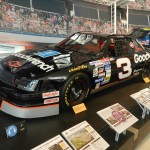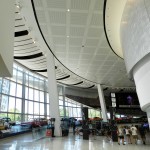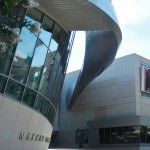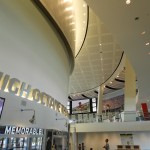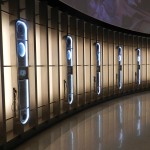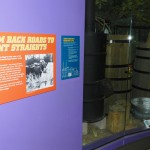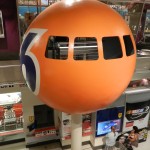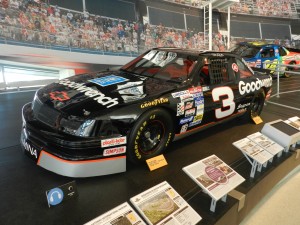
As it turned out, I was already in Charlotte to visit family, so I didn’t have to go far out of my way to get to the Hall of Fame. I was glad I did; the place is fantastic. The building, designed by Pei Cobb Freed and Partners, looks like a spaceship that happened to land on the south end of uptown Charlotte. Inside, the entrance hall resembles the high-sided curve of a race track, with the oldest cars exhibited in front and more recent models, including Richard Petty’s #43 and Dale Earnhardt’s #3, following behind in chronological order, all naturally illuminated by sunlight streaming from huge plate glass windows. Almost all of the building’s walls are curved, and the effect is strikingly futuristic.
The museum has four floors that are accessed by a long ramp that circles alongside the faux race track. On the second floor are the Hall of Fame inductee exhibits. Instead of bronze plaques like those in Cooperstown, NASCAR’s exhibits feature gleaming chrome, accent lighting, and audio testimonials. Further up in the museum are interactive displays, including a pit stop where visitors can race each other to loosen and tighten lug nuts as they get their cars ready to return to the track. Overhead is a large orange Union 76 ball with windows that once housed race spotters at Daytona.
At the top of the museum is a small exhibit acknowledging the illicit aspects of NASCAR’s origins. As Neal Thompson has detailed in his book, Driving with the Devil: Southern Moonshine, Detroit Wheels, and the Birth of NASCAR, many of the early NASCAR drivers and mechanics learned their trade driving and maintaining cars that outran law enforcement to deliver raw, unregulated and untaxed whiskey to thirsty customers. Some NASCAR officials, eager to promote their sport as family-friendly entertainment, have downplayed these origins, but others, perhaps seeing some allure in an outlaw image, have been more willing to acknowledge that there was something of the Dukes of Hazzard to their history.
Those who are not race fans are often puzzled by NASCAR’s appeal. It can seem incredibly boring to watch cars go round and round on a track for three hours, with only an occasional crash to break up the monotony. An explanation can be found in the museum’s High Octane Theater, where visitors see a short film on its wide screen introducing them to the sport. The film effectively presents the atmosphere of seeing a NASCAR race live, and it is immediately apparent that as with hockey, television broadcasts can be ill-equipped to convey a true sense of the event. One scene from the film comes to mind: a camera shot from the stands just above the protective railing as the cars roar by on the track. With the big screen and the enhanced speaker system in the theater, I noticed a few things about a NASCAR race:
1. The cars go very fast.
2. Their engines are extremely loud.
3. They drive insanely close to each other, so that the slightest miscalculation can be the difference between life and death.
From this, I realized that watching a race live, especially in the higher-priced seats close up, is more like a three-hour dose of adrenaline instead of a sports version of watching paint dry. I can see how people can get hooked on the experience. Someday, I may try it but not anytime soon. I have heard that traffic is a nightmare on race days at Sonoma, far beyond the normal gridlock at ballparks, and my entertainment budget is blown for the year from my recent travels. I can thank the Hall of Fame, though, for making the prospect of a NASCAR race attractive. That, I assume, is why they built it.
